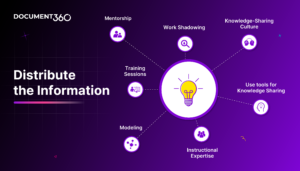There’s a reason why knowledge transfer is such a popular strategy in modern organizations. For one, it can be extremely beneficial when there is a need to transfer the expertise of senior employees in your ranks to the up-and-coming.
It’s also a key component in helping employees grow and advance in their jobs.
In this guide, we’ll walk you through knowledge transfer: why it’s so important, and how to create it for effective communication.
What is Knowledge Transfer?
Knowledge transfer is the process of sharing information or expertise knowledge with other departments or other individuals in a business. It refers to capturing critical knowledge, information and experience and transfer from one entity to another, for maximum efficiency.
Knowledge transfer can be formal or informal. It is a formalized process that can be organized around several goals, such as:
- Providing training and education to internal employees
- Providing training and education to customers and clients
- Transferring technology to external parties

The goal of a knowledge transfer process is to help organizations transfer their knowledge, information, skills, and expertise from one group within an organization or one industry to another.
Formal vs Informal Knowledge Transfer
The difference between formal and informal knowledge transfer lies in the manner in which the knowledge is transferred. You transfer tactical knowledge when you execute informal knowledge transfer. But, formal knowledge transfer deals with the transfer of explicit knowledge.
Here’s the key difference:
Formal knowledge transfer occurs when there are written or verbal instruction manuals or procedures that get passed down from one person to another. This could happen through formal training or workshops.
In comparison, informal knowledge transfer is when there are no written manuals or procedures that get passed down from one person to another. This could be through verbal instructions, emails, or even presentations.
Barriers that Hinder Knowledge Transfer in a Company
It’s true: knowledge transfer comes with a lot of benefits for your company. Sometimes, however, knowledge transfer cannot be successful due to barriers from humans and software alike.
That said, here are some barriers that hinder knowledge transfer in a company:
Inadequate Documentation
The lack of adequate documentation is one of the most common barriers that hinder knowledge transfer in a company. This could be a result of poor communication between employees or a lack of time for appropriate documentation.
Inadequate documentation could also happen in the transfer of tacit knowledge. Tacit knowledge is usually very ingrained in a person and it can be difficult to put it down.
Cultural and Social Challenges
Passing knowledge is more complex than handling information. And sometimes, knowledge can be challenging to accept. The difference in cultural and social views is a big factor in the success of knowledge transfer.
Communication Challenges
Often, communication challenges happen due to a lack of clarity. This could be because of poor language skills, cultural clashes, lack of trust, or lack of clarity in terms of roles and responsibilities.
Geographic Dispersion
With the rise of remote work and the dispersion of employees, come the challenges of transferring knowledge. Despite that, you can make the most of what knowledge transfer tools offer.
Loss of Coordination in Team
Creating an authorization plan should take care of this. Assign someone to oversee knowledge management, and knowledge transfer would be smooth. Also, achieving your knowledge transfer goals would be a breeze when there’s a blueprint to follow.
No Authorized Plan in Place
The lack of an authorized plan is the most uncomplicated barrier to address. Create one. Then, put someone in charge; they will be accountable for management. This helps to affect the plan and make the process effective.
An intuitive internal knowledge base software to easily add your content and integrate it with any application. Give Document360 a try!
GET STARTED
How to Implement the Knowledge Transfer Process
An effective knowledge transfer process can help you capture knowledge, structure the collected knowledge, and distribute it correctly.
But it all begins when you properly capture and organize the knowledge you intend to transfer. And there are several ways that you can do this:
Capture Information
The first step in the knowledge transfer process is to capture information. Capture information about ideas, concepts, and processes that are important to your organization. You can do this using a variety of methods, including interviews, surveys, and documentation reviews.
After gathering the data, organize it in an easy-to-understand format for your audience. This can be done in different ways, such as by creating detailed reports on projects.
You may also want to create visuals like videos or multimedia presentations for visual learners who might have trouble understanding written instructions.
Structure the Collected Information
Without structure, it won’t be clear how employees should use the knowledge they have. You may want to organize the information you have into categories so that employees can see how each document relates to one another as well as all of them together. This will help you find information quickly and easily.
Using reliable knowledge-based software, you can organize your information by keywords, tags, and labels to ease the search in times of need.
Distribute the Information
There are several methods that you can use to distribute knowledge.

1. Mentorship
Mentorship is an effective way to share tacit knowledge. You cannot code the knowledge you need to transfer here into any document. You can best categorize them as abstract knowledge. For instance, through mentorship, new employees can learn how to interact with customers and handle their emotional responses.
2. Instructional Expertise
Instructional expertise is a quality that lies in whoever shares the knowledge. This usually comes from the skilled ability to share knowledge. Individuals with instructional expertise know how to impart knowledge by teaching. So, how can you best apply this? Hire coaches and experts that specialize in knowledge transfer from their work experience.
3. Modeling
In modeling, you show how to do it and guide employees who need knowledge. For example, you can teach new employees to model the exemplary behaviors of current staff.
Modeling is more effective for showing than telling. When leaders are examples of the conduct they desire, transferring knowledge becomes easy.
4. Work Shadowing
Your workplace is already practicing work shadowing through internships and onboarding. But you can derive more gains in knowledge transfer by being deliberate about it.
5. Collaborative Work
It’s not particularly difficult for creative teams to become fragmented when working on a project, whether they are based on-site or remotely. Knowledge management also considers the frameworks essential to fostering collaboration within your creative team.
Don’t miss out on the massive gains in knowledge transfer from apps like Slack, Trello, and Asana. They are effective when distance is a barrier in your knowledge transfer process.
6. Knowledge-Sharing Culture
Even if you know all about knowledge sharing and transfer, what about your employees? Encourage them to understand the benefits a continuous learning culture can bring to the workplace. If nothing else, it makes their work lives easier.
7. Use tools for Knowledge Sharing
The best way to share knowledge is through knowledge-sharing tools that allow people to easily access knowledge internally and collaborate. You can use these tools to store important documents and build a knowledge database.
And when building a knowledge base, consider Document360.
For both internal teams and customers, it is an all-inclusive knowledge-based solution. Through Document360, you can easily distribute training materials, promote employee sharing of information, and encourage employees to express their expertise. You can assess team performance in sharing knowledge by using the analytics feature.
8. Training Sessions
Internships, onboarding, and quality training remain prominent ways to make your employees perform better. Yet, a knowledge-sharing culture can implement the distribution of knowledge.
Measure the Success
The success of your knowledge transfer program will be measured by the number of people who are trained and the effect on their performance. Before implementing a knowledge transfer process, create a clear idea of what you want to achieve.
Then, evaluate the success of your knowledge transfer process by evaluating pilot programs and surveys or simply asking employees for feedback.
Once you have adequate data, use this information to adjust your strategy as needed. Regardless, you’ll benefit more from a knowledge management system.
Also Read: 7 Knowledge Management Challenges and Solutions
Brainstorm and Discover New Ideas
Knowledge transfer is an iterative process; you need to keep capturing and distributing as much information as possible. Train employees to document the discovery of new ideas or processes.
You can also take advantage of collaboration tools to capture feedback and survey tools to capture employee ideas about how best to implement new processes or policies.
These discussions provide opportunities for employees to ask questions, which helps ensure that they have all the information they need when making decisions.
Benefits of Knowledge Transfer in Organizations
Knowledge transfer plays an important role in the knowledge management process within an organization. It can facilitate a structured communication process in which employees share experiences and information with others so that they can learn from it and build upon it.
Build Knowledge-Sharing Culture
Creating a knowledge transfer process establishes a knowledge-sharing culture within an organization which ultimately leads to better communication, higher levels of innovation, and greater efficiency among employees and management alike
Avoid Reinventing the Wheel
Knowledge transfer allows employees to learn new skills and take on new responsibilities without having to reinvent the wheel each time. When employees learn from their colleagues’ experiences and mistakes, they can focus on developing their skills and gaining the knowledge necessary to do their jobs well.
Retain the Knowledge From Employees Leaving Your Organization
When you lose an employee, you also risk losing the valuable knowledge that they may have about your organization. But with a knowledge transfer process, you can make sure this does not happen.
By creating a knowledge base, you ensure that the right information is captured, stored, and available even after an employee quits.
Collective Knowledge Helps With New Ideas
Having a knowledge transfer process gives employees access to relevant information to make better decisions and come up with new ideas. This creates a space for innovation and encourages employees to work together and openly discuss ways to improve.
Nurture and Create a Better Learning Environment
Knowledge sharing creates an environment where employees feel comfortable sharing their ideas, thoughts, and experiences with each other. This leads to better communication within the organization as well as improved teamwork
Reduce Internship Time
With written documentation of your processes, you can cut down on training time. New hires can be trained faster and more efficiently than if they had to learn from scratch.
Ramp-up Productivity
Employees are more productive when they have access to a wealth of knowledge. When an employee has access to the collective wisdom of their organization, they are able to make better decisions and solve problems more easily. This means that less time is wasted on research and more time is spent focusing on core tasks.
Assist Transition to Perform New Roles
You’ll agree that employers won’t struggle to fit into new roles when there’s a knowledge base. In fact, with a broad knowledge base, they would be keen to take up new challenges. It would also help your organization avoid the hard knocks of a difficult transition.
Conclusion
Effective knowledge transfer stimulates business growth and assembles a super workforce. And with the right knowledge base and management, the possibilities are infinite.
Ready to implement an effective knowledge transfer process in your company? Book a demo call with the Document360 team to build a code-free knowledge base.





 –
– 

